
Pros
- Best overall image quality we’ve tested
- Best-in-class glare reduction in a bright rooms
- Superior contrast and off-angle viewing
- Ultrathin panel with external input box
Cons
- Expensive
- Slightly diminished contrast in bright rooms
When we test high-end OLED TVs side by side in CNET’s TV lab, the picture quality differences can be subtle. But that wasn’t the case with the Samsung S95D, which has one huge advantage compared to other OLEDs: a matte screen. And if you’ve ever been bothered by reflections from windows, lamps or other light sources while you’re watching a big screen, you’ll want to keep reading.
The Samsung S95D’s matte finish does more than reduce reflections, it nearly eliminates them, improving image quality in bright rooms more than any OLED TV we’ve tested. Some non-OLED models have matte screens, but this is the first time they’ve been available in an OLED TV, a display technology that has always delivered the best picture available. That matte finish really works, reducing windows and other glare to dimmer blobs instead of super-bright, mirror-like distractions.
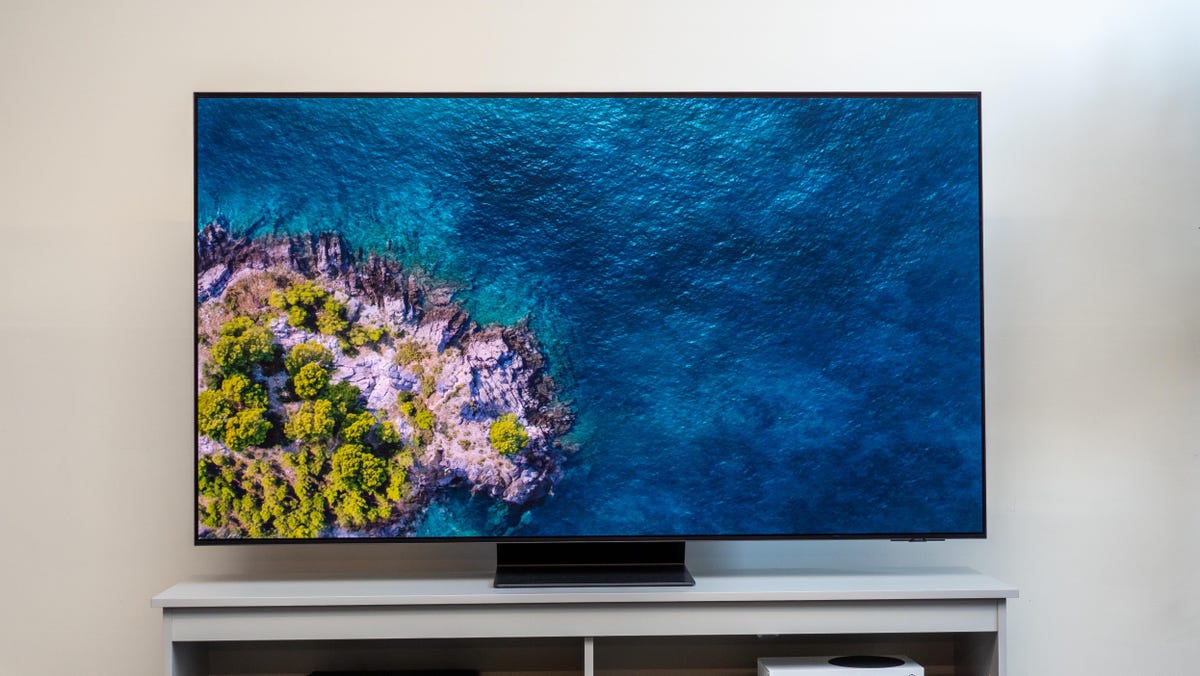
There is a downside, however. In bright rooms, the finish also reduces image contrast, making the screen appear somewhat duller than competitors we tested, like the LG G4 — another excellent OLED TV with a more traditional glossy finish. So, like most things in life, the S95D’s screen finish is a compromise, but all told, it leads to a better picture in a bright room regardless of the contrast hit.
Here’s where we mention that you’ll always experience a better picture when you watch in darker rooms because the TV doesn’t have to compete against ambient light. In those « home theater » situations, the matte screen didn’t detract from image quality at all. In our dark room tests, the S95D and the G4 looked equally superb and largely identical.
Between its versatile matte screen and awesome picture overall, the Samsung S95D delivers the best image quality of any TV we’ve tested, beating both the G4 and last year’s winner, the G3, as well as any other non-OLED TV. But it also costs a ton, and most people — even those with bright rooms — will be perfectly happy with a less expensive TV.
Samsung S95D OLED TV sizes, series comparison
We performed a hands-on evaluation of the 65-inch S95D, but this review also applies to the other screen sizes in the series. All sizes have similar specs and should provide basically the same picture quality.
Samsung is also selling two less expensive OLED series, the S90D and S85D, which are available in a wider range of screen sizes. The main picture quality difference is that the S95D has that matte screen finish while the other two have the more common glossy screen. Another difference is the inclusion of a One Connect box with the more expensive S95D.
Samsung (keeps) HDMI in a box, adds matte screen
Samsung’s antiglare screen technology is evident even when the TV is off. Instead of a traditional glossy, dark mirror-like finish, it looks like a glazed donut.
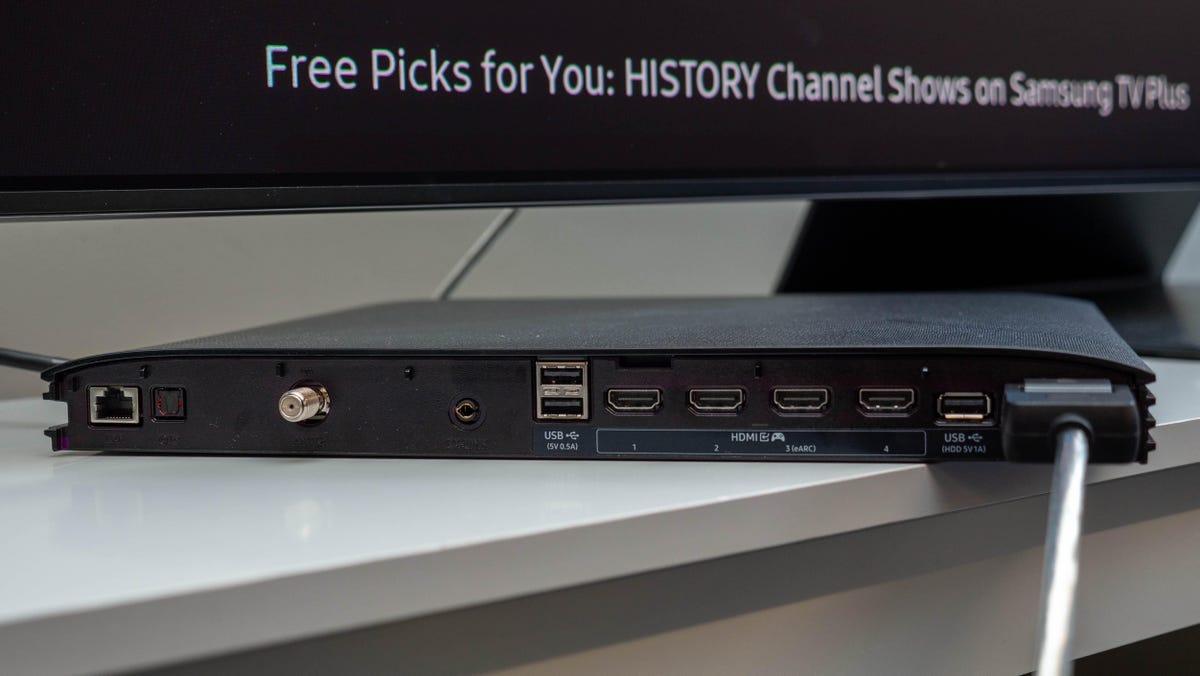
A single cable runs to the TV while all sources connect to an external One Connect box.
But that’s not the only novel part of the S95D’s design. The One Connect box is a big external slab (11.5 by 13 by 1 inch) that houses all of the TV’s inputs and its lone power cord. It connects to the TV itself via an 8-foot silver cord or a smaller one, should you decide to piggyback the box to the back of the TV. You connect your devices, like a cable box, streaming device or game console, to the box instead of directly to the TV, allowing the sources and box to be stashed in a cabinet and deliver a one-cable installation to the panel.
With no need for inputs on the back, the S95D panel itself is astonishingly thin at just 11mm deep, even thinner than the LG G4. Although high-end OLED TVs are typically quite thin, the S95D takes it to another level with its One Connect box. This eliminates a cluster of cables streaming from the rear of the TV but is also appealing if you want to wall mount the TV and have it sit as flush to the wall as possible. Still, we wouldn’t say it sets the S95D apart substantially from the also-super-thin G4. The front is clean and minimalist, and the rear is marked by circular pods that help augment the built-in speakers.
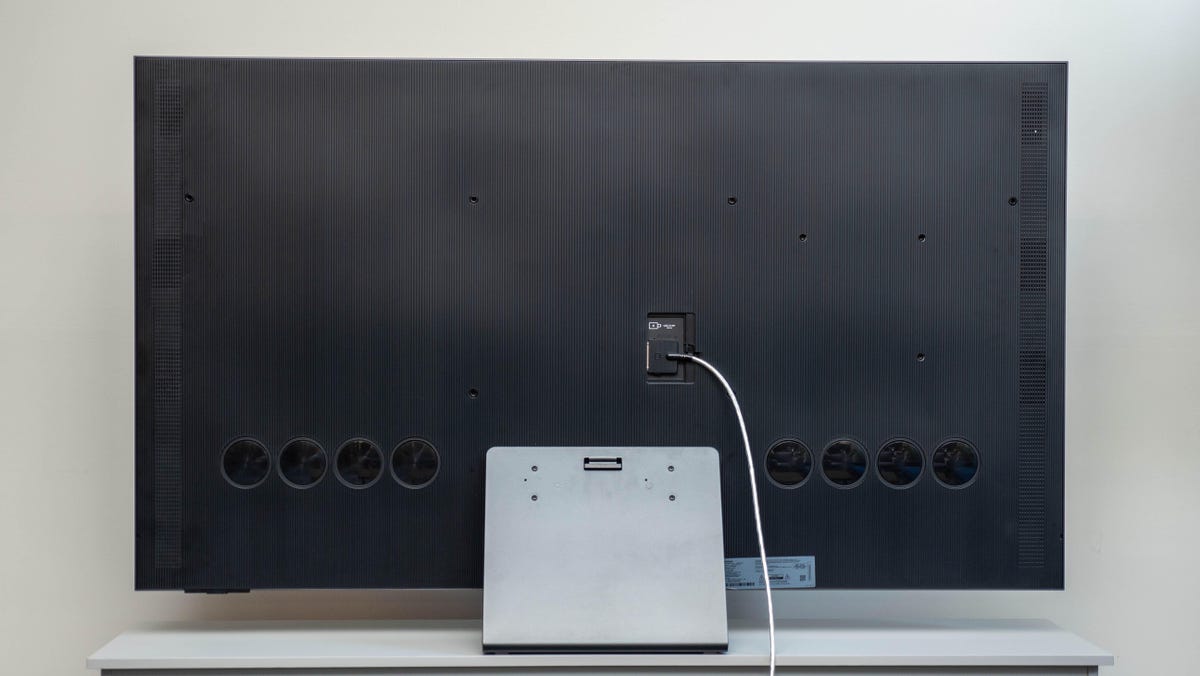
Even the rear of the S95D is interesting. Just a single cable, no power or HDMI, is required.
The Samsung remote is among our favorites. Its simplicity mirrors a number of streaming device remotes in design (think: Roku remote, but slicker) and includes shortcuts to Netflix, Disney Plus and Prime Video. The remote has a microphone for voice commands and a solar panel on the back to charge, although you can also plug it in.
The menu system, which can be called up along the left side of the screen, is fairly user-friendly. It has shortcuts to ambient mode — which displays pictures when the screen isn’t in use — and the Samsung Gaming Hub, where you can play cloud-based games, including Xbox Game Pass and Nvidia GeForce Now, or access connected consoles. Shortcuts on the main menu lead to the usual streaming services and Samsung’s free TV service, but overall we still prefer the simplicity of Roku or the personalization of Google TV.
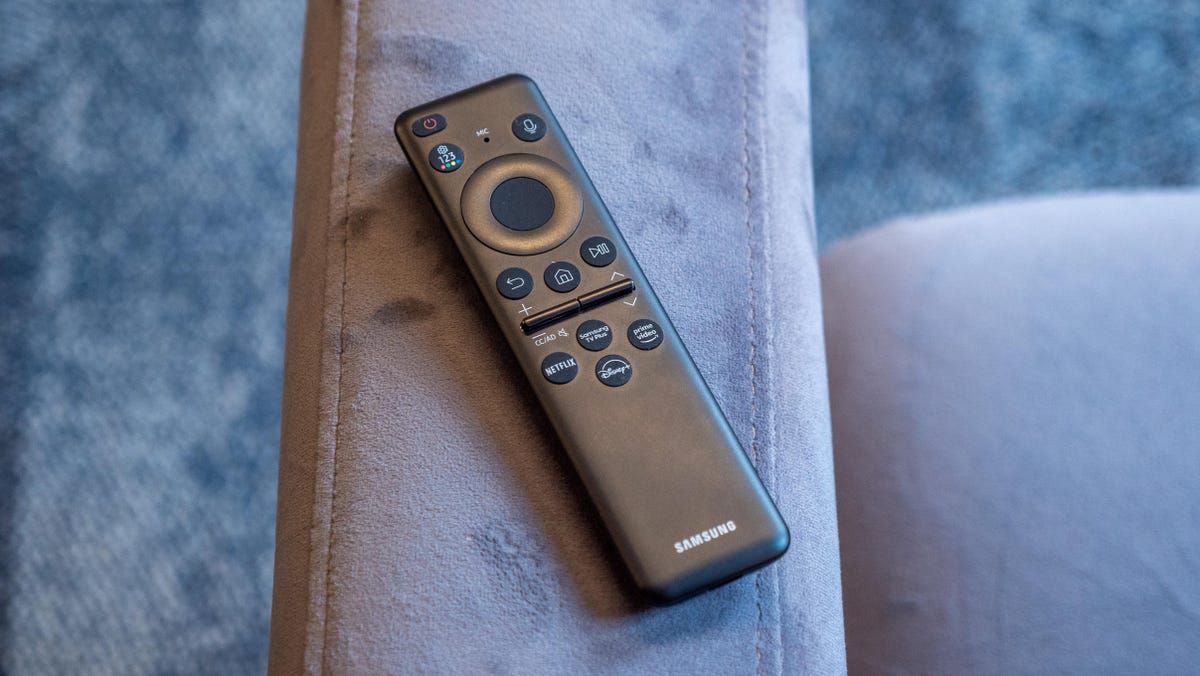
Samsung kept the remote simple.
We found the input menu, particularly, hard to navigate. It’s accessible via the « connected devices » button on the main menu, which differs somewhat from other TV menus that would simply call it « inputs. » One plus of the connected devices menu, though, is the TV will remember which input you accessed last, say HDMI 1 for your Xbox, and recommend it front and center on the home screen when you turn your TV on next. So, the input settings are a slight annoyance to navigate initially, but if you’re a one-input pony, it should be better thereafter.
Quantum Dots enhance color
Samsung’s QD-OLED TVs like the S95D contain Quantum Dots, which promise to enhance color quality and brightness in the already top-of-the-line picture quality of OLED TVs. According to our tests the S95D does a great job with color and brightness, and both categories were a bit better than on non-QD-OLED TVs like the LG G4, but the difference wasn’t drastic.
Read more: Putting the ‘Q’ in QLEDs: Where Quantum Dots Are Made
Unlike most high-end TVs, the S95D does not have Dolby Vision HDR. Neither did its predecessor. Ultimately, we don’t consider this a major drawback. Again, connectivity is all housed in the One Connect external box and includes:
- Four HDMI 2.1 inputs
- Three USB ports
- Optical digital audio output
- Wi-Fi 5
- Bluetooth 5.2
- Ethernet
High-end OLED comparison: Samsung S95D vs. LG G4 and C4
TV and movies: In a dark room, we compared the Samsung S95D side-by-side to the LG G4, G3 and C4. The Samsung S95D was the best-performing TV we’ve tested. Its closest competition was the 2024 LG G4, and the two were exceedingly similar, but the Samsung was slightly brighter and with better color and got the nod.
We started by comparing the S95D to the G4 with the Spears and Munsil 4K benchmark and the two were so close as to be almost indistinguishable. Colors appeared slightly different, with a more saturated red in the tulips and strawberries on the Samsung and the grass under the cows looking deeper and more realistic on the LG. In highlights, both looked equally bright to the eye, but the Samsung measured slightly brighter in most cases. With the sun rising over the mountains, for example, the S95D measured about 520 nits to the LG’s 450, according to a spot check on the light meter.
Black levels on both were perfect, as expected on any OLED TV. We looked closely at the objects against black backgrounds, for example, a honey dripper, and there didn’t appear to be any additional cloudiness or brightness in the black areas closest to the honey on either one. In the shot of a Ferris wheel, the Samsung revealed slightly more detail in the dark areas under the pier and above the buildings, but the difference was very subtle.
When we watched 3 Body Problem on Netflix, the differences were similar and slight. Auggie (Elza Gonzalez) on the train showed skin tones that appeared a bit more flush and natural on the S95D in a side-by-side comparison, but the difference was nearly indistinguishable. Areas of white sky and clouds looked slightly bluer and less accurate in the brightest parts on the LG, a difference that was evident in measurements as well, but again, it wasn’t major by any means. Overall, both TVs looked superb in home theater situations, and we doubt anyone would be able to point to a difference beyond a side-by-side comparison.
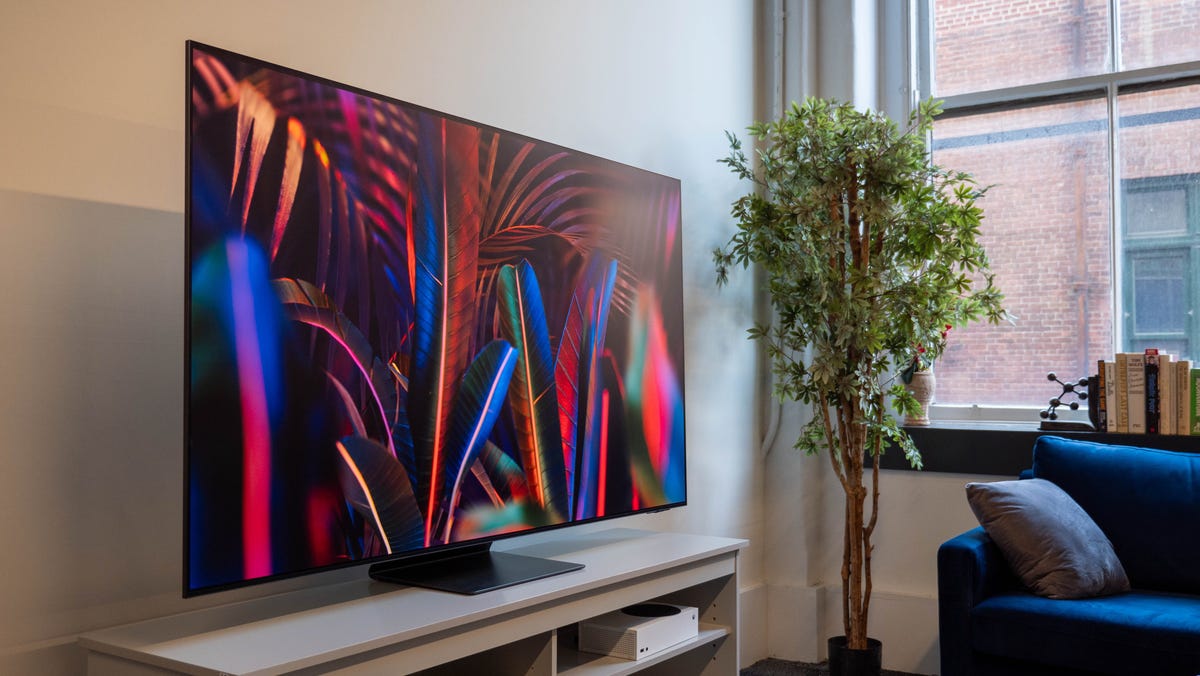
Above, the Samsung S95D in a bright room. Notice the relatively muted reflection of the window in the upper right of the screen. In comparison, the same reflection on a glossy-screen OLED TV is much brighter and more distracting. Bright lighting: The « glare-free » matte finish on the Samsung S95D is a big benefit in bright rooms since it greatly reduces distracting reflections. When we set up the S95D next to the LG G4 opposite a bright window, the Samsung looked markedly better overall because it reduced the brightness of the windows reflected on the screen. Instead of a sharp, mirror-like reflection visible in the LG (and other OLED TVs we’ve tested), the S95D’s reflection was softer, more diffuse and less distracting, especially when watching darker scenes. On the other hand, the glare-free finish delivered worse black levels in bright lighting. The difference was most noticeable with a bright overhead light, which caused the Samsung’s screen to look a bit grayer (as opposed to true black) and washed out, for a somewhat less impactful image than we saw on the LG. Again, the difference was most obvious in darker scenes, and in brighter ones, the two were more equalized. Overall, however, the pros of the finish outweigh the cons in most bright rooms. Beyond its screen finish, the S95D’s brightness is also an asset. According to our measurements, it and the G4 were basically tied for the title of « brightest OLED TV ever. » Both TVs have over 1,700 nits, outpacing the previous title holders — the G3 and S95C from 2023 — by more than 300 nits.
As usual, Samsung’s brighter picture modes (Standard and Game, respectively, for SDR and HDR) were quite inaccurate. For the accurate results listed above, we used Filmmaker mode for both SDR and HDR. We recommend S95D owners choose Filmmaker for all HDR sources since it’s almost as bright as Standard and much more accurate. It’s also a couple hundred nits brighter than the same mode on the G4. The S95D is easily the best-performing OLED TV we’ve ever tested for bright rooms with its excellent matte-screen finish and superior brightness in its accurate modes. Gaming: The S95D is also among the best gaming TVs we’ve tested. Its Game Bar, which displays picture modes, minimap, resolution, refresh rate and HDR status, among other things, is well thought-out and easy to use. Comparing the image quality in the default standard mode to that of the LG G4, the Samsung was brighter and more dynamic looking, while the LG has a more dramatic, cinematic look that better suited the game (Lies of P on Xbox Game Pass). Both TVs offer numerous picture modes to try, and in Samsung’s case, most were relatively similar aside from the Original, which was quite a bit darker. The LG has a wider variety of fine-tuning options, however, allowing you to dial in something like shadow detail (important for spotting hidden enemies, for example) and additional tweaks like a Dark Room mode. Fine adjustments for Samsung are found in either of the two Custom picture modes, and you can also adjust smoothing options (although we don’t find that very useful). The input lag was superb, at around 9 milliseconds in game mode, basically the same as the LGs. According to the Xbox’s details screen, the Samsung supported 4K/120Hz and VRR but not Dolby Vision (which LG does support). Uniformity and viewing angle: The S95D delivered the superb viewing angle and uniformity we expect from an OLED TV. It’s as good as any other OLED and superior to non-OLED TVs. Just as we saw with the S95C last year, the S95D’s most accurate HDR preset was Filmmaker, with an EOTF that tracked the target more closely than Movie mode (which was too bright in the middle range). Standard was slightly brighter than either but much less accurate and exceedingly blue. In SDR mode, Filmmaker was a bit more accurate than Movie and equally bright, so we used Filmmaker. Both were accurate to the BT.1886 target gamma Samsung used as default, but note for our Geek Box results above we changed the gamma setting to 2.2.
Portrait Displays Calman calibration software was used in this review.
->Google Actualités
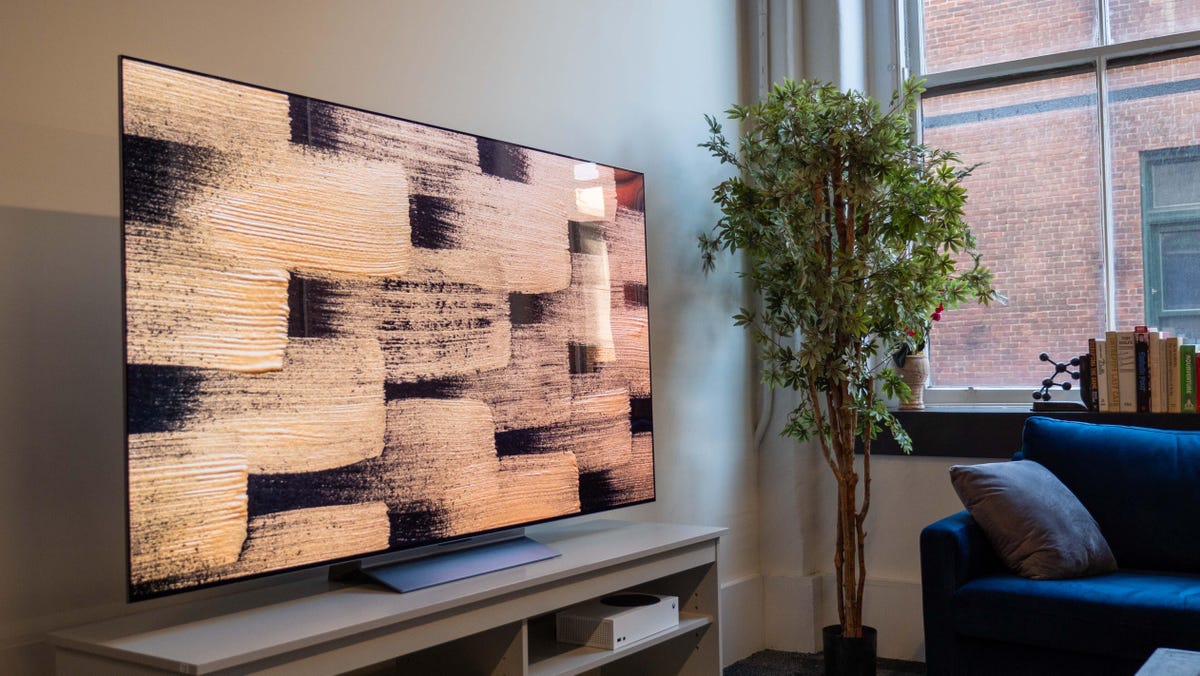
Light output in nits
TV
Brightest mode (HDR)
Accurate mode (HDR)
Brightest mode (SDR)
Accurate mode (SDR)
LG G4
1,799
1,420
792
792
Samsung S95D
1,734
1,666
544
265
Hisense 65U8K
1,966
1,966
1,720
1,240
Vizio Quantum Pro (2024)
1,269
1,063
1,382
221
Vizio M65QXM-K03 (2022)
939
742
958
608
LG OLED65C3
861
817
501
464
Roku TV Plus
514
455
579
404
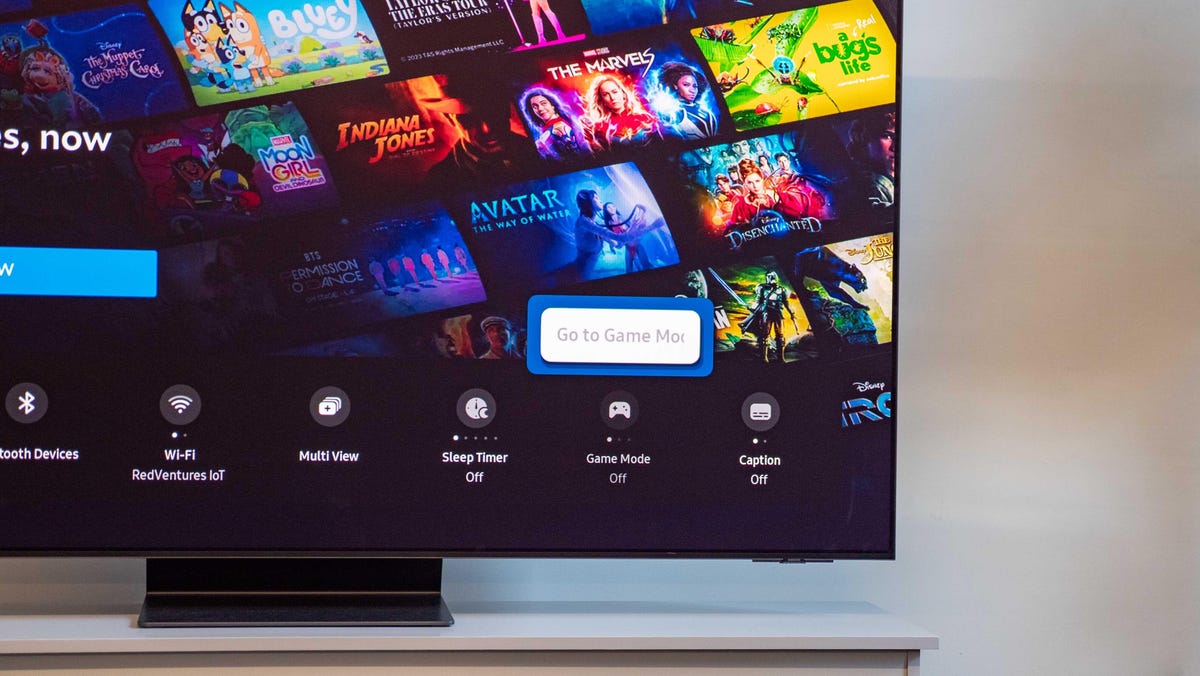
Picture setting notes and test results
Geek Box
Test
Result
Score
Black luminance (0%)
0.000
Good
Peak white luminance (SDR)
544
Good
Avg. gamma (10-100%)
2.16
Good
Avg. grayscale error (10-100%)
1.04
Good
Dark gray error (30%)
1.61
Good
Bright gray error (80%)
0.66
Good
Avg. color checker error
0.92
Good
Avg. saturation sweeps error
0.07
Good
Avg. color error
1.26
Good
1080p/24 Cadence (IAL)
Pass
Good
Input lag (Game mode)
9.83
Good
HDR10
Black luminance (0%)
0.000
Good
Peak white luminance (10% win)
1734
Good
Gamut % UHDA/P3 (CIE 1976)
99.97
Good
ColorMatch HDR error
1.96
Good
Avg. color checker error
1.13
Good
Input lag (Game mode, 4K HDR)
9.73
Good










